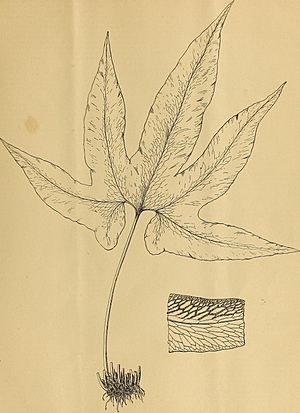Bommeria facts for kids
Quick facts for kids Bommeria |
|
|---|---|
 |
|
| Bommeria elegans | |
| Scientific classification |
|
| Kingdom: | Plantae |
| Clade: | Tracheophytes |
| Class: | Polypodiopsida |
| Order: | Polypodiales |
| Family: | Pteridaceae |
| Subfamily: | Cheilanthoideae |
| Genus: | Bommeria Fourn. |
| Species | |
Bommeria is a group of small ferns that grow on rocks. These ferns are found in the New World, which means North and South America. Scientists have studied their DNA to understand how they are related to other ferns. They found that Bommeria is a very old group of ferns in the Pteridaceae family. For a long time, people thought Bommeria was closely related to another fern group called Hemionitis. But DNA tests showed that Hemionitis is actually a more modern type of fern.
Scientists also found that Bommeria is a "natural group." This means all the ferns in the Bommeria genus are closely related to each other.
Contents
What Makes Bommeria Special?
Bommeria ferns are known as "gymnogrammoid" ferns. This means their spore cases, called sori, are not covered. They are found in lines along the veins on the underside of the fern leaves, which are called fronds. This feature made people think they were related to Hemionitis.
Most ferns in the Pteridaceae family have their sori in straight lines along the edge of the frond. These sori are often covered by a protective flap called an indusium, or by a folded part of the leaf. The way Bommeria ferns have their sori is different. It seems this trait can appear in different fern groups independently.
Appearance of Bommeria Ferns
The stems of Bommeria fern leaves are called stipes. These stipes are usually hairy and have some small, flat scales. The fronds (leaves) themselves are also hairy, both on the top and bottom. The hairs on the top are short and sharp. The hairs on the bottom can be straight or curled. You can also find scales on the underside of the fronds.
About the Name
The genus Bommeria was named to honor a Belgian botanist named Jean-Édouard Bommer. Scientists have also studied the chromosomes of these ferns. The basic number of chromosomes for this genus is 30 (n=30), which means a typical plant cell has 60 chromosomes (2n=60).
Species of Bommeria
As of January 2020, the Checklist of Ferns and Lycophytes of the World lists the following species in the Bommeria genus:
- Bommeria ehrenbergiana – Found in Mexico.
- Bommeria elegans – Also found in Mexico.
- Bommeria hispida – Known as the copper fern. It grows in Mexico and parts of the United States, including Arizona, New Mexico, and Texas.
- Bommeria pedata – Found in western Mexico and Central America.
- Bommeria subpaleacea
See also
 In Spanish: Bommeria para niños
In Spanish: Bommeria para niños

